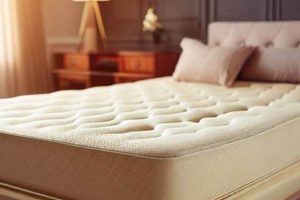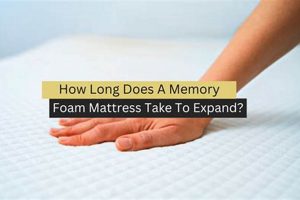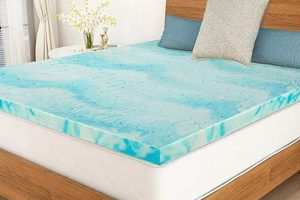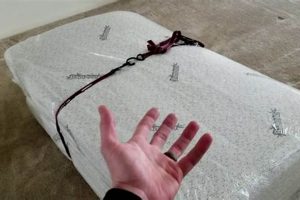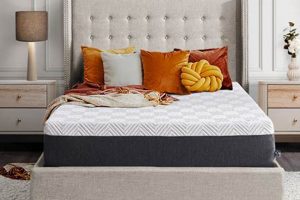A sleeping surface engineered with viscoelastic foam, designed for babies, conforms to the body to distribute weight evenly and reduce pressure points. This type of product often features a firm core for safety and is typically encased in a removable, washable cover. Such mattresses are intended for use in cribs or bassinets meeting specific size and safety standards.
The selection of an appropriate sleep surface for newborns and young infants is a crucial decision for caregivers. The materials used and the firmness level can influence comfort and potentially impact the child’s well-being during periods of rest. Prioritizing models with certifications from recognized safety organizations provides assurance regarding material content and manufacturing processes, offering parents increased peace of mind. Historically, these mattresses represent an evolution from traditional innerspring or cotton batting designs, reflecting advancements in material science and a heightened awareness of infant safety standards.
The subsequent sections will delve into specific aspects of these sleep surfaces, including safety considerations, material composition, proper care and maintenance, and factors to consider when making a purchase. This information is designed to assist caregivers in making informed decisions regarding their child’s sleep environment.
Guidance on Selecting and Utilizing Infant Memory Foam Mattresses
The following recommendations aim to provide clarity on the effective selection and implementation of viscoelastic foam mattresses designed for infants, prioritizing safety and optimal sleep conditions.
Tip 1: Prioritize Safety Certifications: Verify that the chosen mattress carries certifications from reputable organizations such as CertiPUR-US or GREENGUARD Gold. These certifications indicate the foam has been tested for harmful chemicals and volatile organic compounds (VOCs), ensuring a safer sleep environment.
Tip 2: Assess Firmness Levels: A firm mattress is crucial for infant safety. Ensure the chosen mattress provides sufficient resistance to prevent the baby from sinking into the surface, reducing the risk of suffocation.
Tip 3: Confirm Proper Fit within the Crib: Measure the interior dimensions of the crib precisely. The mattress should fit snugly, with no gaps exceeding two finger widths between the mattress edge and the crib frame. This minimizes the risk of entrapment.
Tip 4: Utilize a Waterproof Mattress Protector: Employ a fitted, waterproof mattress protector underneath the crib sheet. This safeguards the mattress from spills and accidents, preventing moisture build-up and maintaining hygiene.
Tip 5: Maintain a Clean Sleep Environment: Regularly wash the mattress protector and crib sheets in hot water to eliminate dust mites and allergens. Avoid using harsh chemicals or detergents that could irritate the baby’s skin.
Tip 6: Rotate and Flip the Mattress Periodically: Distribute wear and tear evenly by rotating and flipping the mattress, if applicable, every few months. This can extend the lifespan of the product and maintain its supportiveness.
Tip 7: Monitor for Signs of Wear and Tear: Inspect the mattress regularly for any signs of degradation, such as sagging, indentations, or tears. Replace the mattress if any significant damage is observed.
Adhering to these guidelines promotes a secure and sanitary sleep surface for infants. Prioritizing certified materials, appropriate firmness, and proper maintenance will contribute to a safer and more comfortable rest.
The succeeding sections will provide further insights and concluding remarks regarding the considerations surrounding these specialized sleep products.
1. Firmness is paramount
The selection of an infant memory foam mattress necessitates a rigorous evaluation of firmness, as this factor is directly linked to infant safety and well-being during sleep. Unlike adult mattresses designed for pressure relief and comfort, the firmness of an infant mattress serves a critical preventative function.
- Suffocation Risk Mitigation
Excessively soft mattresses can create pockets or indentations that conform closely to the infant’s face, potentially obstructing airways and increasing the risk of suffocation. A firm surface maintains its shape, preventing such obstructions and allowing for unimpeded breathing.
- Developmental Spinal Support
Infants lack the muscular control and skeletal development necessary to maintain proper spinal alignment on a yielding surface. A firm mattress provides the necessary support for the developing spine, promoting healthy posture during sleep and minimizing the risk of musculoskeletal issues.
- Reduced Risk of Re-Breathing Expelled Air
Softer surfaces can trap exhaled carbon dioxide near the infant’s face, leading to re-breathing of stale air. A firm mattress promotes better air circulation around the infant, reducing the concentration of carbon dioxide in the immediate sleep environment.
- Consistency and Predictability
Consistent firmness across the entire mattress surface ensures a uniform sleep environment. Varying levels of firmness can create uneven support, potentially leading to discomfort and restless sleep. A uniformly firm surface provides a predictable and stable foundation for the infant.
The stringent firmness requirements for infant memory foam mattresses underscore the primacy of safety over comfort considerations typical of adult sleep surfaces. Manufacturers must adhere to rigorous testing and certification standards to ensure their products meet the necessary firmness criteria for infant safety. Caregivers should prioritize mattresses that demonstrably meet these standards.
2. Material Safety
The composition of an infant memory foam mattress directly impacts the health and safety of the child. The materials utilized in its construction must meet stringent standards to mitigate potential risks associated with chemical exposure and allergenic reactions. The selection process necessitates careful consideration of the materials’ inherent properties and their potential long-term effects on infant well-being.
- Volatile Organic Compounds (VOCs)
Memory foam mattresses may release VOCs, which are emitted as gases from certain solids or liquids. Some VOCs can have adverse health effects, particularly in infants, including respiratory irritation and developmental issues. Low-VOC or VOC-free certifications, such as CertiPUR-US, indicate the foam has been tested and meets specific emissions standards. Real-life examples include toluene and formaldehyde, which are VOCs that may be present in some foams. Selecting a mattress with minimal VOC emissions is c
rucial for ensuring a safe air quality in the infant’s sleep environment. - Flame Retardants
Regulations often mandate the use of flame retardants in mattresses to reduce fire hazards. However, certain flame retardant chemicals have been linked to adverse health effects. Manufacturers are increasingly using alternative, less harmful flame retardant materials or barrier fabrics that eliminate the need for chemical treatments. Examples include silica or inherently flame-resistant fibers. Caregivers should investigate the specific flame retardant treatment used and prioritize mattresses utilizing safer alternatives.
- Allergenic Potential
The materials used in the mattress cover and foam core may trigger allergic reactions in some infants. Common allergens include latex and certain dyes or chemical treatments. Opting for hypoallergenic materials, such as organic cotton or bamboo, and avoiding mattresses with known allergenic substances can minimize the risk of allergic reactions. Regularly washing the mattress cover can further reduce allergen exposure.
- Heavy Metals
Trace amounts of heavy metals, such as lead or mercury, may be present in some mattress components, particularly in imported or unregulated products. Exposure to heavy metals can have detrimental effects on infant development. Seeking mattresses from reputable manufacturers that adhere to strict quality control standards and regularly test for heavy metals is essential for ensuring product safety.
The various material safety facets collectively underscore the critical need for informed selection when purchasing an infant memory foam mattress. By carefully considering the potential risks associated with VOCs, flame retardants, allergens, and heavy metals, caregivers can significantly minimize the likelihood of adverse health effects. Prioritizing mattresses with reputable certifications and transparent material disclosures is crucial for safeguarding infant well-being during sleep.
3. Proper Crib Fit
The dimensional congruence between an infant memory foam mattress and the interior of the crib is a non-negotiable safety requirement. Deviations from standardized measurements pose significant risks to infant well-being, potentially leading to entrapment or suffocation hazards. This section elucidates the critical facets of achieving a proper crib fit.
- Dimensional Accuracy
Cribs adhere to specific internal dimensions mandated by safety regulations. An infant memory foam mattress must conform precisely to these dimensions, leaving no excessive gaps between the mattress edge and the crib frame. Gaps exceeding two finger widths create a space where an infant could become trapped, leading to potential injury or suffocation. Manufacturers typically provide mattress dimensions; these should be meticulously compared against the crib’s internal measurements.
- Corner Radius Compatibility
The corners of the mattress should align seamlessly with the corners of the crib. A mattress with excessively rounded or squared corners may leave gaps, even if the overall dimensions are seemingly correct. This aspect of fit is often overlooked but crucial for preventing small extremities from becoming lodged in the corner spaces. Visual inspection of the corner alignment is essential during installation.
- Mattress Thickness Considerations
While length and width are paramount, mattress thickness also contributes to proper crib fit. Excessively thick mattresses may reduce the effective height of the crib railing, potentially allowing a mobile infant to climb out. Conversely, a thin mattress may exacerbate the gap issue along the sides. Mattress thickness should be compatible with the crib’s intended mattress support height.
- Consistent Support Surface
The mattress must rest uniformly on the crib’s support structure, whether slats or a solid platform. Uneven support can lead to localized sagging or tilting, creating an unsafe sleep surface. Ensure the crib’s support structure is intact, level, and capable of providing consistent support across the entire mattress area.
Achieving a proper crib fit transcends mere convenience; it represents a fundamental safety imperative in ensuring a secure sleep environment. Thorough measurement and meticulous alignment of the infant memory foam mattress within the crib frame are indispensable steps in safeguarding infant well-being.
4. Waterproof Protection
Waterproof protection is an essential consideration when selecting an infant memory foam mattress. The porous nature of memory foam renders it susceptible to liquid absorption, creating an environment conducive to bacterial growth and material degradation. Implementing effective waterproof measures is crucial for maintaining hygiene and prolonging the mattress lifespan.
- Fluid Barrier Integrity
The primary function of waterproof protection is to prevent liquids, such as spills, bodily fluids, and moisture, from penetrating the memory foam core. This barrier minimizes the risk of mold and mildew formation, which can pose respiratory health hazards to infants. Typical examples include polyurethane films or laminated fabrics applied to the mattress surface. The effectiveness of this barrier is directly proportional to its ability to remain intact over time, even with repeated washing and use.
- Hygiene and Sanitation
Infants are prone to accidents, making waterproof protection integral for maintaining a sanitary sleep environment. The barrier allows for easy cleaning and disinfection of the mattress surface, preventing the accumulation of bacteria and allergens. Without this protection, absorbed fluids can create a breeding ground for microorganisms, potentially leading to skin irritations or infections. The material used should be non-toxic and easily cleaned with mild soap and water.
- Odor Control
Absorbed fluids can lead to unpleasant odors that are difficult to eliminate from memory foam. Waterproof protection acts as a preventative measure, containing spills and preventing odor-causing substances from permeating the mattress core. This is particularly important given the sensitivity of infants to environmental odors. Effective waterproof layers are designed to be breathable, allowing air circulation while preventing liquid penetration.
- Mattress Longevity
Moisture intrusion can compromise the structural integrity of memory foam, leading to premature degradation and loss of support. Waterproof protection safeguards the foam from moisture damage, extending the mattress lifespan and preserving its firmness. This protection is an investment in the long-term usability and safety of the infant’s sleep surface.
The integration of effective waterproof protection into infant memory foam mattresses represents a critical design element for ensuring hygiene, safety, and durability. Caregivers should prioritize mattresses with reliable waterproof features to maintain a clean and healthy sleep environment for the infant.
5. Maintenance Matters
Sustained utility and safety of an infant memory foam mattress are directly contingent upon consistent and appropriate maintenance practices. The intended benefits of the mattress, such as pressure distribution and conforming support, can be diminished by inadequate care, leading to potential health and safety implications for the infant. For instance, neglecting to clean spills promptly can foster microbial growth within the foam core, creating a breeding ground for allergens and pathogens. This, in turn, may exacerbate respiratory issues or trigger skin irritations in susceptible infants. Routine maintenance is, therefore, not merely a matter of hygiene but a critical component of ensuring the continued suitability of the sleep surface.
Proper maintenance encompasses several key aspects. Regular vacuuming with a HEPA filter-equipped device helps to remove dust mites and surface debris, minimizing allergenic exposure. Spot cleaning with mild, non-toxic detergents addresses localized stains and spills, preventing permanent damage and discoloration. Importantly, the mattress cover, if removable, should be laundered frequently according to the manufacturer’s instructions to eliminate accumulated allergens and maintain a clean sleep surface. Overlooking these measures can lead to a gradual degradation of the mattress’s protective properties, rendering it less effective and potentially harmful over time. For instance, the waterproof lining can delaminate if subjected to improper cleaning agents or excessive heat, compromising its barrier function.
In summary, proactive maintenance of an infant memory foam mattress is essential for preserving its intended performance and ensuring a safe sleep environment. The long-term benefits of this specialized sleep product are directly correlated with the diligence and consistency applied to its upkeep. Failure to adhere to recommended maintenance protocols can negate the inherent advantages of the mattress, potentially exposing the infant to avoidable health risks. Thus, understanding and implementing appropriate maintenance practices are crucial responsibilities for caregivers utilizing these mattresses.
Frequently Asked Questions
The following section addresses common inquiries regarding the use and selection of viscoelastic foam mattresses designed for infants, aiming to provide clarity and informed guidance.
Question 1: Are all memory foam mattresses safe for infants?
No. Adult memory foam mattresses are often too soft and pose a suffocation risk to infants. Specialized infant memory foam mattresses are engineered with a firm core and safety certifications to mitigate such risks.
Question 2: How can one verify the safety of an infant memory foam mattress?
Safety certifications, such as CertiPUR-US or GREENGUARD Gold, indicate the foam has been tested for harmful chemicals and VOC emissions. These certifications provide a measure of assurance regarding product safety.
Question 3: What is the ideal firmness level for an infant memory foam mattress?
Infant mattresses require a high degree of firmness to prevent the baby from sinking into the surface. A firm mattress maintains its shape and reduces the risk of suffocation. Test the firmness by pressing firmly on the mattress; it should offer substantial resistance.
Question 4: How frequently should an infant memory foam mattress be cleaned?
The mattress surface should be spot cleaned immediately after any spills. The mattress cover, if removable, should be laundered regularly according to the manufacturer’s instructions, ideally every one to two weeks.
Question 5: What are the potential risks associated with using a used infant memory foam mattress?
Used mattresses may harbor bacteria, allergens, and structural damage that are not readily visible. Unless the history and condition of the mattress are known with certainty, it is generally advisable to purchase a new mattress for infant use.
Question 6: What type of crib sheets are most appropriate for use with an infant memory foam mattress?
Fitted crib sheets made from breathable materials, such as cotton or muslin, are recommended. Ensure the sheets fit snugly and securely to prevent loose fabric from posing a suffocation hazard.
The preceding questions and answers underscore the importance of careful consideration when selecting and utilizing an infant viscoelastic foam mattress. Prioritizing safety, hygiene, and appropriate maintenance practices is crucial for ensuring a secure sleep environment.
The subsequent section will provide concluding remarks summarizing the key considerations surrounding these specialized sleep products.
Conclusion
This exploration has underscored the critical considerations surrounding the selection, utilization, and maintenance of infant memory foam mattresses. From firmness requirements and material safety to proper crib fit and waterproof protection, each aspect contributes to a secure and hygienic sleep environment. Consistent adherence to recommended practices is paramount in mitigating potential risks and maximizing the benefits associated with these specialized sleep products.
The decision to use an infant memory foam mattress warrants thorough research and a commitment to ongoing vigilance. Prioritizing certified products, implementing diligent maintenance routines, and remaining attentive to evolving safety guidelines are essential responsibilities for caregivers. The long-term health and well-being of the infant depend on the conscientious application of this knowledge, ensuring a safe and restful sleep foundation during this crucial developmental stage.


![Find the Best Foundation for Memory Foam Mattress [Guide] Organic & Natural Mattress Buyer’s Guide: Non-Toxic Sleep Solutions Find the Best Foundation for Memory Foam Mattress [Guide] | Organic & Natural Mattress Buyer’s Guide: Non-Toxic Sleep Solutions](https://mattressworldpa.com/wp-content/uploads/2025/07/th-3968-300x200.jpg)
